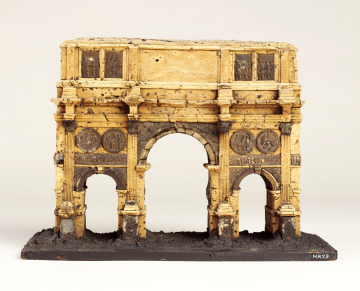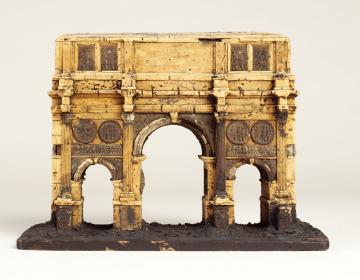Explore Collections


You are here:
CollectionsOnline
/
Model of The Arch of Constantine, Rome
Browse
Model of The Arch of Constantine, Rome
Cork
Height: 18.7cm
Width: 26cm
Depth: 6cm
Width: 26cm
Depth: 6cm
Museum number: MR29
On display: Model Room (pre-booked tours only)
All spaces are in No. 13 Lincoln's Inn Fields unless identified as in No. 12, Soane's first house.
For tours https://www.soane.org/your-visit
Curatorial note
The Arch of Constantine is one of the most well-known monuments in Rome and was raised by the Senate in 315 AD (it was dedicated on 25 July 315 AD). It commemorates Emperor Constantine the Great's victory at the Battle of the Milvian Bridge, on 28 October 312 AD, over his rival, the tyrant Maxentius, who had ruled Rome since 306 AD. The Arch stands between the Colosseum and the Palatine Hill in Rome, on the spot that was in ancient times the start of the Via Triumphalis.
The Arch incorporates sculptural decoration taken from earlier Imperial monuments, including eight large marble medallion reliefs or tondi dating from the Hadrianic period which are inset on the south and north sides, in pairs.They appear to have come from one earlier monument, perhaps in honour of Hadrian given their common theme of Hadrian hunting and sacrifcing to the Gods. They are all of the same Luna marble and of identical dimensions (about 2.40 metres diameter). The reuse of earlier, classicizing sculpture juxtaposed with later, stylised sculptural decorations dating to the period of Constantine was commented upon by many authors, starting with the Renaissance art historian Giorgio Vasari. The Arch was said to mark the change from Classical art to that of the medieval period.
The roundels include a pair depicting Sol and Luna (Sun and Moon or Dawn/Morning and Sunset/Evening), versions of which (based on full-size casts but remodelled to complete missing elements) can be seen in the Lobby to the Breakfast Room and in the Basement East passage at 13 Lincoln’s Inn Fields. Smaller variants of this pair in plaster and terracotta can also be found in the Dome, Museum Corridor, South Drawing Room and Model Room Recess at the Museum. Another large reused roundel on the Arch shows the Emperor Hadrian and his courtiers setting out for a hunting trip - Soane owned two large plaster versions of that roundel also (in the Dome Area and Hall). In his day it was thought to depict Trajan setting out on a hunting trip. Today the Emperor is identified as Hadrian.
The Arch incorporates sculptural decoration taken from earlier Imperial monuments, including eight large marble medallion reliefs or tondi dating from the Hadrianic period which are inset on the south and north sides, in pairs.They appear to have come from one earlier monument, perhaps in honour of Hadrian given their common theme of Hadrian hunting and sacrifcing to the Gods. They are all of the same Luna marble and of identical dimensions (about 2.40 metres diameter). The reuse of earlier, classicizing sculpture juxtaposed with later, stylised sculptural decorations dating to the period of Constantine was commented upon by many authors, starting with the Renaissance art historian Giorgio Vasari. The Arch was said to mark the change from Classical art to that of the medieval period.
The roundels include a pair depicting Sol and Luna (Sun and Moon or Dawn/Morning and Sunset/Evening), versions of which (based on full-size casts but remodelled to complete missing elements) can be seen in the Lobby to the Breakfast Room and in the Basement East passage at 13 Lincoln’s Inn Fields. Smaller variants of this pair in plaster and terracotta can also be found in the Dome, Museum Corridor, South Drawing Room and Model Room Recess at the Museum. Another large reused roundel on the Arch shows the Emperor Hadrian and his courtiers setting out for a hunting trip - Soane owned two large plaster versions of that roundel also (in the Dome Area and Hall). In his day it was thought to depict Trajan setting out on a hunting trip. Today the Emperor is identified as Hadrian.
The provenance of two of Soane's cork models, MR2 (Tivoli) and MR29 (Arch of Constaintine) was thought to be, as recorded in Soane Museum records, the 'Gowan' sale held by 'Phillips', 1804, but recent research by Dr Richard Gillespie revealed in 2017 that the names were incorrectly recorded and should be McGowan (or McGouan) with the sale not by Phillips but Philipe.The sale catalogue is: Philipe, T. 1804. Catalogue of the Extensive Cabinet of Medals, Coins, Gems, Antiquities, and Books on the Fine Arts. Collected at a Liberal Expence, by John McGouan, Esq. F.R.S. Edin. Deceased. T. Philipe, Warwick Street, Golden Square, London, 8-15 February 1804 [Cadbury Research Library, University of Birmingham]
The seventh day of the sale includes: Lot 245. A cork model of the Sybil’s Temple at Tivoli /
Lot 246. A ditto of the Arch of Constantine, an elegant and elaborate performance, with all the basso relieves, inside and out, in Number 24, height about 7 inches, width about 89, and depth 4. It is contained in a mahogany case, glazed on both sides. The price of £16 for the two models is recorded at the Soane.
John McGouan (or McGowan) (d.1803) was an Edinburgh lawyer and antiquary; he was a fellow of the Society of Antiquaries of Scotland, as well as a foundation member of the Royal Society of Edinburgh. It is not certain whether or not he travelled to Italy, but he did acquire Italian and Asian artefacts (see Beatrice Tessier, ‘Asia in 18th-Century Edinburgh Institutions: Seen or Unseen?’, Proceedings of the Society of Antiquaries of Scotland, 134, 2004, pp.499-556).One possibility is that McGouan acquired the models from his friend Andrew Lumisden, the Jacobite politician and antiquary, who had lived in Rome from 1751-69, working as assistant secretary to the Old Pretender, then subsequently in Paris. By 1773 he had sufficiently distanced himself from the Jacobite cause to be permitted to return to Edinburgh, where he would write Remarks on the Antiquities of Rome and its Environs (1797), a successful account of the classical remains in Rome accompanied by engravings. In his later years he would share apartments with John McGouan in Princes Street, and he died there in 1801; McGouan died two years later at Princes Street. It is possible that the two models were originally acquired by Lumisden in Rome (although the Tivoli model was made in the 1770s, which appears to be after he left Rome) and either given by him during his life or subsequently bequeathed to McGouan (see James Dennistoun, Memoirs of Sir Robert Strange and ... Andrew Lumisden. 2 vols, London, 1855, Vol. 2, pp.151-163 and 273-275.
We are grateful to Dr Richard Gillespie of the University of Melbourne, for sharing his discovery of this provenance and research into John McGouan with us.
Exhibition history
John Soane Architect: Master of Space and Light, Royal Academy of Arts, London, 11 September - 3 December 1999; Centro Palladio, Vicenza, April - August 2000; Hôtel de Rohan, Paris, January - April 2001; Canadian Centre for Architecture, Montreal, 16 May - 3 September 2001; Real Academia des Bellas Artes, Madrid, October - December 2001
Associated items
Soane collections online is being continually updated. If you wish to find out more or if you have any further information about this object please contact us: worksofart@soane.org.uk







